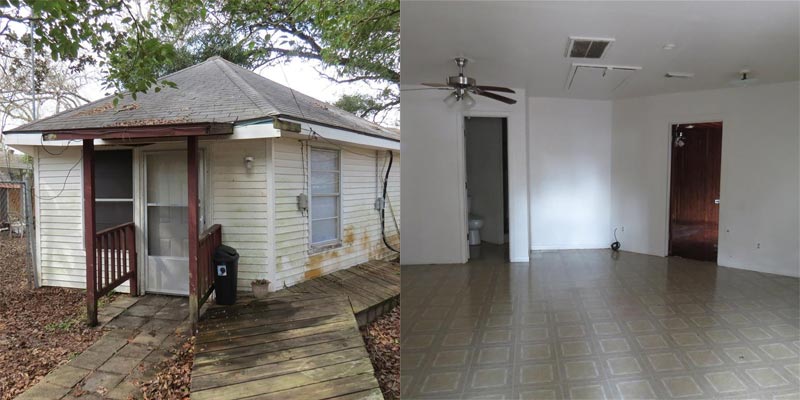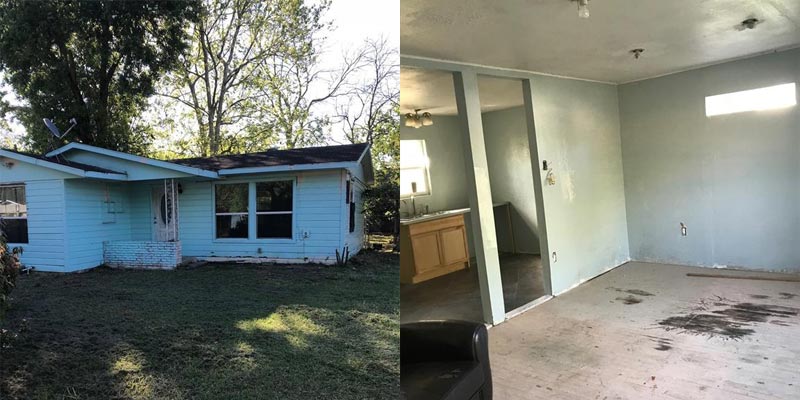Our Approach
Affordable unsubsidized rental rates • High energy efficiency • Low stress • Pride of “ownership” • Community • Self sustaining economics
We didn't invent the shipping container home; we simply have a new idea for them. Other non-profits such as Habitat for Humanity are using shipping containers for "affordable housing," however their model is far too expensive to help extremely low income ("ELI") renters as is building new traditional homes or renovating run down existing housing. An entirely new model is needed.
We plan to start in the Houston-Galveston corridor which has a severe shortage of ELI-affordable housing, and the gap between market rental rates and ELI-affordable rates is a among the largest in the country. According to this 2017 report, the two bedroom fair market rental rate is $976, and the ELI-affordable rate is $536. This means a household needs 2.6 full-time jobs to afford a two bedroom home at current market rates. For a single earner with one full-time job paying minimum wage, the affordable rent is $377/month. Using the non-profit model we've designed for FIRSTPRIORITY, we believe it is possible to achieve these rental rates on an unsubsidized basis.
In addition to the severely limited availability of ELI-affordable houses, many of those that are affordable are not adequate. Far too many people, even those suffering a severe cost burden, are living in appalling conditions. The solution not only has to be priced right and sustainable, it has to be decent home.
Examples of the "supply" in the current market:
 |
|
 |
As of the date this page was written, there isn't a single adequate, ELI-affordable home (<$536/month) for rent in Galveston County. This is the closest to affordable at $600/month for a 500 sqft 1 bedroom built in 1960. The least expensive 2 bedroom available was $800/month. We're targeting <$375/month for our 300 sqft 1BR and <$550/month for our 600 sqft 2BR model. |
|
This home is an example of what $60,000 will currently buy in Galveston County (approximately what we expect it to cost to build our 600 sqft 2BR model including land). Built in 1969, it is a less-than-livable 868 sqft 2BR. Not pictured is the non-functional bathroom. |
Only non-profits can solve this problem.
While there may be opportunities for the for-profit sector, we don't believe that they can provide a generalized solution to the problem because the requirement to make a profit is a principal driving factor in the affordable rent gap. We also don't believe that government can provide a solution. Government can help by removing roadblocks such as land use controls and burdensome permitting processes and by having the political will not to bow to NIMBY (Not In My Back Yard) resistance to affordable housing projects. Notwithstanding, government-mandated solutions tend to have wide-ranging unintended negative consequences and should be avoided. For example, a 2004 policy study found “inclusionary zoning” ordinances which mandate that developers sell a certain percentage of the homes they build at below-market prices to make them affordable for people with lower incomes work to drive away developers and actually restrict the supply of new homes. Such policies both ignore and exacerbate a main cause of the affordability problem: government-imposed artificial restrictions on land supply. We need more construction, not less.
Our plan:
Our plan is to (1) design a limited number of standardized models that are extremely durable, low maintenance, highly energy efficient, and can be rapidly mass-produced at a low cost. We believe shipping container-based homes exploiting a number of efficiencies borrowed from the manufactured home industry (but using standard, high-quality building materials) are the answer. (2) To use the "profit" component that would be required in the for-profit model along with smart design and manufacturing efficiency to bring down the rents to ELI-affordable rates while also accruing an "equity" component that the renter earns for maintaining the property over time. We also believe we will be able to accrue a "pay it forward" element that will serve as payment "insurance" across our client base rather than requiring down payments that can themselves price many ELI renters out of the market. (3) To achieve cost levels that will allow for unsubsidized rents that are sufficient to make the model self-sustaining without the need for ongoing donations, and (4) ultimately, we plan to develop small "pocket" neighborhoods where we will locate these homes in groups of 10-12 around shared community space, playgrounds, pavilions, BBQs, etc. Key elements of our plan include:
Low cost: we are targeting monthly rental costs for nice homes that are comparable to what the renter might otherwise pay to live in a slum. For example, we believe we can realize rends less than $375/month for a one bedroom and less than $550/month for a two bedroom thus achieving ELI-affordable housing.
Energy efficient: in addition to unaffordable rental rates, many ELI renters experience burdensome utility expense as a result of inferior building materials and/or insulation and structural damage common in inadequate housing. We plan to fully insulate our homes with spray-on closed-cell foam insulation to R18, and we believe our renters will realize as much as 80% lower utility costs in cases where the they are coming from a trailer or mobile home with damaged insulation. We also plan to integrate other energy-saving design features such as tankless water heaters and reflective white roofs.
No stress: like most of us take for granted, we want our renters to have a place to come home to with no electrical or plumbing problems, no leaks, no drafts, and no pests. It works or we fix it. We will strive to be the anti-slumlord.
Life changing: our renters will accumulate "equity" with each month’s rent payment that they can take with them or pass on to their families if they maintain the property as agreed. This means that people who today can’t put together two months rent as a security deposit to qualify as a renter will not only be able to rent, but they will also be able to experience a "pride of ownership” similar to a homeowner. We believe this is an important first step to building a community.
Community: in short order after proving out the design concept and economics, we want to develop communities: life-changing homes in life-changing neighborhoods with shared outdoor space, parks, playgrounds, a community pavilion, BBQs, etc. We believe community is important for security and for creating a sense of belonging, care, and support. We want to build neighborhoods that encourage live interaction among neighbors, laying the groundwork for caring relationships that ease the daily stress, struggles, and challenges of life.
Self-sustaining: We believe we can create a "perpetual motion" model where the cashflow generated from rentals is sufficient to service the debt and maintain the property without on-going donations. This is not to say that we won't seek donations to accelerate the process of providing decent homes to as many people as possible, rather that we don't want to rely on donations to subsidize our rental-rate targets.
Advantages of Shipping Containers for ELI-Affordable Housing
Proven: shipping containers are well-established as highly effective, low-maintenance housing structures.
Quick and inexpensive to build: we believe shipping containers are ideal for mass production of standardized floorplans at a low cost rapid pace that stick-built houses simply can’t achieve.
Adaptable: the four pier foundation design allows for easy and inexpensive adaptation to any flood zone elevation requirement opening up new areas for affordable housing.
Extremely strong and long lasting: shipping containers are strong enough to withstand category 5 hurricane force winds without damage. Unlike mobile home and trailer exteriors, the shipping shipping container envelope is extremely durable and will remain robust for an indefinite time resisting leaks, structural problems, and pests - something mobile homes and manufactured housing can't claim.
Eco-friendly: the US is a net-importer of goods, so there is an ever growing supply of shipping containers. Recycling them into houses saves energy and conserves natural resources.
|